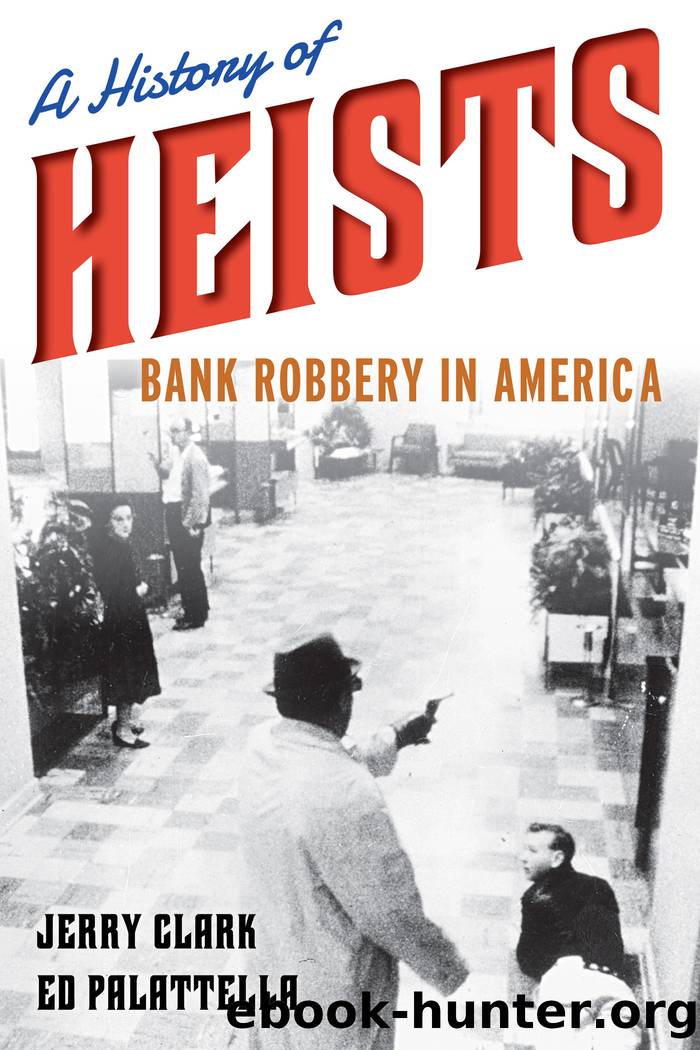A History of Heists by Jerry Clark

Author:Jerry Clark
Language: eng
Format: epub
Tags: undefined
Publisher: Rowman & Littlefield Publishers
Published: 2012-01-15T00:00:00+00:00
More deaths of public enemies soon closed out âThe Year of the Gangster,â as 1934 was known. Hooverâs men, still investigating the Kansas City Massacre, shot and killed the thirty-year-old Pretty Boy Floyd on the farm near East Liverpool, Ohio, on October 22, 1934. Floyd admitted nothing before he died. On November 27, 1934, FBI agents killed Baby Face Nelson near Barrington, Illinois, in a gun battle in which Nelson killed two special agents, Sam Cowley and Herman Hollis, who had both staked out Dillinger outside the Biograph. Agents killed Ma Barker and her son Fred on January 16, 1935, in Ocklawaha, Florida. On May 1, 1936, the FBI, with Hoover present, arrested Alvin Karpisâthe last Public Enemy Number One, wanted for kidnapping, bank robbery, and other crimesâin New Orleans. He was convicted and sent to Alcatraz, where he spent twenty-six years, the longest tenure for an inmate at the Rock, until he was paroled in 1969.[87]
By 1935, when Hoover launched the FBIâs battle against bank robbers, the agency had already achieved huge public-relations coups with the deaths of Dillinger and the others. The FBI went on to triumph on the movie screen as well. Gangster movies, so popular before the imposition of the Hays Code, gave way to equally popular movies that celebrated the FBI. Though strict imposition of the Hays Code went into effect in 1934, virtually prohibiting the making of gangster movies, the Motion Picture Producers and Distributors of America approved an exemption. It allowed on-screen violence to occur in antigangster moviesâfilms whose heroes were FBI agents. What followed, through September 1935, was a cycle of G-men movies about J. Edgar Hooverâs FBI. They included Public Hero Number One (May 1935), starring Lionel Barrymore; Whipsaw (December 1935), starring Myrna Loy and Spencer Tracy; and Show Them No Mercy (also in December 1935), starring Cesar Romero.[88] These movies were still violent, and still focused on gangsters: âThey now made the FBI agents the nominal heroes, but gave the same fat parts to the gangsters. As a sop, they had the gangster killed or punished at the end.â[89] Just as bank robbery helped create the modern FBI in real life, so bank robbers, gangsters, kidnappers, and other crooks provided the foils that made the FBI agents stars of the G-men movies.
The most influential of these films, the movie that most shaped the public image of the FBI, was G-Men, released in April 1935. It was made by Warner Brothers, which had produced so many of the gangster movies (The Public Enemy, Little Caesar, Scarface), and its star was James Cagney, also the lead in The Public Enemy. In G-Men, Cagney plays James âBrickâ Davis, a lawyer who trains as a G-man after his friend, already an agent, is killed while trying to arrest a gangster. Davis pursues gangsters as the G-menâs agencyâa cinematic stand-in for Hooverâs FBIâdemands more police powers to fight the crime wave. The G-men win in the end, to the adulation of an adoring nation. G-Men
Download
This site does not store any files on its server. We only index and link to content provided by other sites. Please contact the content providers to delete copyright contents if any and email us, we'll remove relevant links or contents immediately.
| Espionage | Hoaxes & Deceptions |
| Murder & Mayhem | Organized Crime |
| Serial Killers | White Collar Crime |
Mindhunter: Inside the FBI's Elite Serial Crime Unit by John E. Douglas & Mark Olshaker(9206)
Wiseguy by Nicholas Pileggi(5674)
Room 212 by Kate Stewart(5040)
Hitman by Howie Carr(5021)
Secrecy World by Jake Bernstein(4651)
Killers of the Flower Moon: The Osage Murders and the Birth of the FBI by David Grann(4387)
Papillon (English) by Henri Charrière(4199)
Breaking Free by Rachel Jeffs(4175)
Killers of the Flower Moon by David Grann(3971)
Say Nothing by Patrick Radden Keefe(3903)
American Kingpin by Nick Bilton(3759)
The Secret Barrister by The Secret Barrister(3615)
Molly's Game: From Hollywood's Elite to Wall Street's Billionaire Boys Club, My High-Stakes Adventure in the World of Underground Poker by Molly Bloom(3486)
Mysteries by Colin Wilson(3397)
In Cold Blood by Truman Capote(3311)
Signature in the Cell: DNA and the Evidence for Intelligent Design by Stephen C. Meyer(3075)
I'll Be Gone in the Dark by Michelle McNamara(3024)
Rogue Trader by Leeson Nick(2977)
Bunk by Kevin Young(2950)
